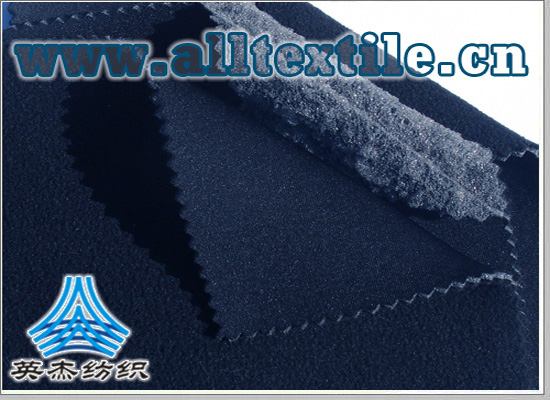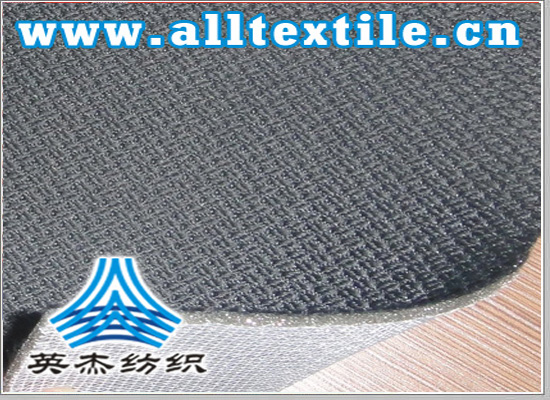【Knowledge】Flame retardant fabric
PS: Flame-retardant fabric is not inflammable. Even if it is ignited by an open flame, it will automatically extinguish within 12 seconds after leaving the open flame.
The so-called flame retardant does not mean that the textiles after flame retardant treatment will not burn when exposed to a fire source, but means that the fabric can reduce its flammability in the flame, slow down the speed of spread, and will not cause a large area of burn; and leave the flame Afterwards, it can self-extinguish quickly and no longer burn or smolder. At present, the main varieties of flame-retardant fibers include: flame-retardant polyester, flame-retardant nitrile chlorofiber, flame-retardant vinylon, flame-retardant viscose, arylsulfone fiber, glass fiber, polytetrafluoroethylene fiber, polyamide-imide fiber, polyamide-imide fiber, Benzimidazole fiber, phenolic fiber, etc.

The basic principle of flame retardant fiber is to reduce the generation of flammable gases during thermal decomposition and hinder the basic reactions during gas phase combustion. Secondly, absorbing heat in the combustion area, diluting and isolating the air also plays a certain role in preventing combustion.
Basic principles of fabric flame retardancy
1. Surface covered with flame retardant
Some substances (such as boron yarn, boric acid, etc.) melt when heated, forming a glass-like film on the surface of the fiber, which can hinder the supply of oxygen; or like phosphide, it mainly acts in the solid phase, promotes carbonization, and prevents flammability. Release of gas. Some flame retardants may also decompose by heat, producing incombustible gases that float on the fiber surface to isolate air or dilute flammable gases, thereby producing a flame retardant effect, such as CO2 gas generated by the thermal decomposition of KHCO3.
2. Heat-absorbing and flame-retardant
Through endothermic dehydration, phase change, decomposition or other endothermic reactions of the flame retardant solvent, the temperature of the polymer surface and combustion zone is reduced, thereby slowing down the thermal decomposition rate of the polymer. Such compounds include Al2O3·3H2O, TiO2, TiO3, ZnO and BaO, etc. The reason why Al2O3·3H2O can inhibit combustion is that when heated, this trihydrate compound absorbs heat and can delay the temperature rise. When the temperature rises to 222°C to 230°C, alumina trihydrate decomposes into anhydrous alumina and water, which can absorb more heat, and water vapor can dilute and cool flammable gases to achieve flame retardancy.
3. Condensed phase flame retardant
Condensed phase flame retardant mainly uses flame retardants to affect the decomposition process of polymers and reduce the generation of flammable gases. This method is particularly effective for cellulosic materials.
When cellulose is heated, it can thermally decompose in two directions. It can form volatile organic flammable low molecular substances through the intermediate product of levoglucosan; in addition, it can form water under the catalysis of acidic substances. and nonflammable carbon.
4. Vapor phase flame retardant
It is generally believed that during the combustion process of polymers, a large number of free radicals are generated to promote the gas-phase flame retardant reaction. If we can try to capture and destroy these free radicals, we can control combustion and achieve the purpose of flame retardancy. Practice has proven that the flame retardant performance can be significantly improved by adding a small amount of inhibitors that have the effect of capturing free radicals. This method is also very effective in preventing the spread of flames by free radicals.
5. Wall effect of dust particles
When free radicals come into contact with the wall or surface of dust particles, they may lose activity. The following reaction can occur on dust particles or container walls: H•+O2=HO2•
In this way, a large amount of HO2•, which has much lower activity than H•, HO•, etc., is generated on the surface of the dust particles, which can inhibit the continuation of the combustion process.
6. Droplet effect
Some thermoplastic synthetic fibers, such as polyamide and flame-retardant polyester, shrink and melt when heated, reducing the contact area with air, and even droplets may fall and leave the fire source, which hinders combustion to a certain extent. For blended fabrics of cellulose fiber and polyester fiber, the cellulose fiber does not melt and hinders the droplet action of polyester, making their flame retardant modification more difficult.
Flame retardant finishing processes for several common fabrics

1. Flame retardant finishing of linen fabrics
(1) Temporary flame-retardant finishing: After finishing, the fabric can maintain excellent fire-retardant properties, but the flame-retardant effect will disappear once washed. Generally, it can be washed less than 15 times. After a period of time, fireproofing must be carried out again to restore the fireproofing performance. Such finishing agents include: metal oxides and halides of titanium and antimony, ammonium hydrogen phosphate and amine sulfamate, boric acid, borax, etc. This type of finishing agent is mainly suitable for curtains, curtains, and decorative fabrics that are not frequently washed.
(2) Semi-durable flame retardant finishing: The flame retardant effect can be maintained for a long time after finishing, but will disappear after multiple washings. Generally, it can be washed 15-50 times. The most frequently used finishing agent of this type is a mixture of tetrahydroxymethyl chloride and dicyandiamide.
(3) Durable flame retardant finishing: Durable flame retardant finishing agents use chemical methods to polymerize or copolymerize inside or on the fiber to form a layer of polymer that is insoluble in water and general solvents, or use latex resin to make the insoluble polymer Water-resistant flame retardant plasticThe agent adheres to the fibers. The most commonly used finishing agent of this type is tetrahydroxymethylphosphorus hydroxide. New flame retardant systems should be developed in the direction of halogen-free, low-smoke, and non-toxic. The flame-retardant finishing agent used for linen fabrics should not only achieve green and environmental protection, but also aim to improve the comprehensive flame-retardant properties of linen fiber fabrics.
2. Durable flame-retardant finishing of polyester fabrics
So far, a very suitable and ideal flame retardant has not been found for the flame retardant finishing of polyester fabrics. The current mainstream use of cyclic phosphonates has relatively good flame retardant effect on polyester, is not very toxic, and meets environmental protection requirements.
Product features: Suitable for flame-retardant processing of 100% polyester fiber washable type; does not contain halogen and formaldehyde; can withstand washing; the baking temperature is at least 180°C; used with PU resin as a coating, it also has good flame retardancy characteristic.
3. Flame retardant finishing of wool fabrics
Wool is not a flammable fiber because it has high moisture regain (8%-16%), nitrogen content (15%-16%) and sulfur content (3%-4%). The earliest flame-retardant finishing of wool used borax and boric acid solution impregnation method. This method has good flame retardant effect, but it is not resistant to water washing. After the 1960s, THPC treatment was used, which has better washing resistance, but the process is complicated, the hand feels rough, and the quality of wool fabric is lost.
Under acidic conditions (generally pH is controlled around 2.5), the temperature is 70°C, and the treatment is for 30 minutes. This technology can be performed before and after dyeing or during the dyeing process. Its flame retardant mechanism is that under acidic conditions, the amino groups on wool change into nitrogen-based cations, react with the flame retardant anions, and produce adsorption. When burned, it can increase the formation of char and reduce the generation of flammable gases, thereby achieving flame retardancy. the goal of.
4. Flame retardant finishing of nylon fabrics
Mainly using sulfur-containing flame retardants, such as thiourea, ammonium thiocyanate, ammonium sulfate, sulfur guanidine, etc., can achieve better effects on nylon finishing, but such flame retardants are not washable flame retardants.
5. Flame retardant finishing of acrylic fabrics
Acrylic fiber is more flammable than polyester and nylon, with an oxygen index of only 18-18.5, making it an easy-to-burn fiber. The School of Textile and Clothing of Qingdao University has researched and developed a series of flame retardants for acrylic velvet decorative fabrics. For the flame retardant coating on the back of the velvet fabric, the product has an oxygen index of more than 29, a carbon length of less than 8 cm, and basically no subsequent burning or smoldering. , the acrylic velvet decorative fabrics developed can be used for sofas, decorative fabrics, etc. in cars, airplanes, hotels, and homes.
6. Flame retardant finishing of polyester-cotton blended fabrics
Polyester/cotton blended fabrics are used in large amounts, and the research on flame-retardant products is quite active. Polyester and cotton fabrics are two types of fibers with different combustion properties. At the same time, blending makes the combustion process more complicated. Cotton fibers are carbonized after burning, while polyester melts and drips when burned. Because the cotton fibers become a support, the molten fibers can gather and prevent them from dripping, making the molten fibers burn more violently, which is the so-called “scaffold effect”. Therefore, polyester/ Flame retardant finishing of cotton blended fabrics is more difficult. Generally, the ammonia fumigation method is used twice for finishing or the bromine-antimony composite system (such as the aqueous dispersion of decabromodiphenyl ether and antimony trioxide) is used, and the rolling and baking process is used for finishing; there are also some nitrogen-phosphorus flame retardants abroad. Can be used for flame retardant finishing of polyester/cotton.

Flame retardant finishing method
1) Padding and baking method: the most widely used flame retardant finishing process. The process flow is padding-prebaking-baking-post-processing. Padding fluid is generally composed of flame retardants, catalysts, resins, wetting agents and softeners, and is configured into an aqueous solution or emulsion for finishing.
2) Dip and bake method (absorption method): The tissue is immersed in the flame retardant liquid for a certain period of time, and then dried and baked to make the flame retardant liquid absorbed by the fiber polymer.
3) Organic solvent method: It uses non-water-soluble flame retardant. Its advantage is low energy consumption during flame retardant finishing. However, in actual operation, attention should be paid to the toxicity and flammability of solvents.
4) Coating method: Mix the flame retardant into the resin, and the flame retardant is fixed on the fabric through the adhesion of the resin. According to different mechanical equipment, it is divided into blade coating method and pouring coating method.
development trend
(1) Develop efficient, non-toxic flame retardants with little impact on material properties. This leads to the development of reactive flame retardants and the development of additive flame retardants with better compatibility.
(2) Develop synergistic flame retardants, such as molecular or intermolecular combinations of phosphorus, nitrogen, and bromine.
(3) Development of a series of flame retardants with different application ranges.







